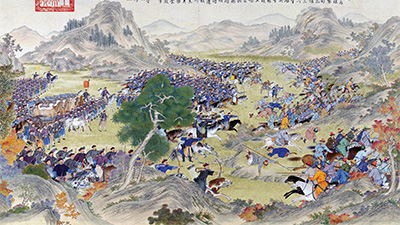Land-Based Empires
Teacher Resources
Driving Question: How did land-based empires in Afro-Eurasia expand their influence and govern diverse communities between c. 1450 and 1750 CE?
The collapse of the Mongol Empire allowed for the emergence of several large land-based empires in Eurasia. The empires in this unit all had large, multicultural, and multiethnic populations. Rulers had to devise ways to keep their subjects in line and relatively happy to avoid civil unrest. They also learned strategies from their predecessors about centralizing authority and maintaining control over diverse populations.
Learning Objectives:
- Understand how land-based empires developed, expanded, and maintained power from c. 1450 to 1750.
- Work on informal writing skills to evaluate the themes of this unit.
Vocab Terms:
- cannon
- devshirme
- gunpowder
- sultan
- Sunni
- tax
- tsar
Opener: Land-Based Empires c. 1450–1750
To teach this lesson step, refer to page 2 of Lesson 3.0 Teaching Guide.
Want to connect to other WHP AP® World History teachers? Join the OER Project Community Forum.
When people think about history, they often believe that life was very different in the past—and in many ways it was! But you might find that, in other ways, there are a surprising number of similarities to our lives now.
Unit 3 Overview
To teach this lesson step, refer to page 3 of Lesson 3.0 Teaching Guide.
This thread in the Community Forum provides some teacher suggestions for approaching Unit 3.
Can you imagine how hard it is for a teacher to keep control of a classroom? Or a coach to control a team? It’s a lot of work. Now imagine controlling an entire region! Phew!
-
Guiding Questions
-
Before you watch
Preview the questions below, and then review the transcript.
Before you watch the video, it’s a good idea to open and skim the video transcript. And always read the questions below so you know what to look and listen for as you watch!
While you watch
Look for answers to these questions:
- What are some of the ways governments get their citizens to abide by their rules?
- Who was Suleiman?
- What states rose to power after the Mongol Empire fractured and what do historians often call these states?
- How did these land-based “gunpowder empires” compete with each other from 1450 to 1750?
- How did these land-based empires maintain control of their territory and subjects?
- What was the millet system and why was it used in the Ottoman Empire?
- What was the devshirme and why was it used in the Ottoman Empire?
After you watch
Respond to the following questions:
- How do Suleiman’s titles represent how rulers established their authority and how do the AP® themes relate to these titles?
- If you were to compare how land-based empires in this era exercised authority and maintained power with governments of today, what would be two of the most significant similarities and two of the most significant differences?
Key Ideas
Unit 3 Introduction: Land-Based Empires 1450 to 1750
To teach this lesson step, refer to page 4 of Lesson 3.0 Teaching Guide.
Weapons are often used by empires to defend and conquer; however, successful empires use various strategies to maintain control.
-
Guiding Questions
-
Before you read
Preview the questions below, and then skim the article. Be sure to look at the section headings and any images.
While you read
Look for answers to these questions:
- What were the “gunpowder empires”? Why were they called that?
- Why was gunpowder a revolutionary technology? How did it change power structures?
- Other than gunpowder, what strategies helped the five empires mentioned in the text succeed in expanding across and controlling so much territory?
- How was Europe similar to and different from these land-based empires during this period?
After you read
Respond to the following questions:
- In the previous unit, we explored the vast trade networks that flourished during the period of Mongol dominance in Afro-Eurasia. These networks declined during the period of Mongol collapse. How do you think trade networks were affected by the rise and expansion of these large land-based empires that competed with each other for dominance and territory?
- If you were going to compare empires with each other, what kinds of factors or dimensions do you think you would be looking at?
Closer: Land-Based Empires c. 1450–1750
To teach this lesson step, refer to page 5 of Lesson 3.0 Teaching Guide.
Our Openers and Closers Guide will provide more information about these short, but important, activities at the beginning and end of each lesson.
Have you noticed any patterns of thought in this Unit? This is the time to identify and categorize them using the Themes Notebook.




